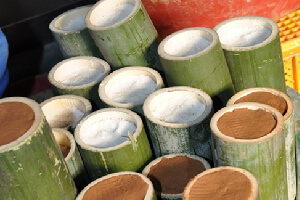Why Korean Bronzeware Is So Expensive
Narrator: Making bangjja yugi starts here, with molten bronze. And after hundreds of hammer strikes, it’s transformed into some of Korea’s most expensive tableware. Artisans work with fires over 1,300 degrees Celsius, carefully reheating the metal between rounds of hammering. Too hot, and it will melt. Too cold, and it’ll shatter. No molds are used in this process, only skill and an experienced eye. When it’s done, this rice pot can sell locally for over $350. So, what makes bangjja yugi so labor-intensive? And is that why it’s so expensive?
Bangjja yugi refers to Korean hand-forged bronzeware. It can take many forms, from pots to gongs. While bangjja yugi production has largely been modernized, Lee Bong-ju is one of few yugi masters who continue to produce certain pieces using traditional methods. Bong-ju, who is 96, has been making traditional Korean bronzeware for over 70 years.
Lee Bong-ju: It seems to me that bangjja yugi is my destiny rather than a choice.
Narrator: In 1983, the South Korean government declared him a “living national treasure.” A single spoon fully handcrafted by Bong-ju’s team costs $70. A set of seven bowls costs over $1,800.
Bong-ju starts off by measuring the ingredients. The perfect bronze alloy for bangjja yugi is in the details – an exact ratio of 78% copper and 22% tin. The metals are heated to over 1,300 degrees Celsius in order to melt and boil. Although the alloy will melt at a lower temperature, Bong-ju says that heating it to 1,300 degrees ensures it can stretch without cracking once cooled.
Lee Bong-ju: If we don’t follow the ratio, the bronze doesn’t stretch. Even if it stretches, there will be holes all over it. We can’t make products that way.
Narrator: They then pour the molten alloy into a heated stone with a round cutout. Once the alloy cools, it becomes a bronze plate with a rounded bottom, referred to as a baduk. Bong-ju’s team heats the cooled baduks again, so they can hammer them without risking breakage. One person cannot hammer the bronze alone, as they won’t be able to move fast enough before the metal cools. Working quickly in a circle, artisans strike the red-hot baduk, stretching it until it’s the desired size. Each careful blow of the hammer plays an essential role in shaping valuable yugi. This also means one misplaced hit could cause irreparable damage.
Lee Bong-ju: One person’s mistake can break metal when hammering.
Narrator: And it’s not just the hammering that can ruin the baduk. Every step of the traditional process is manual, down to fanning the fire. Fanners push and pull the bellows, creating wind to keep the fire going. They depend on experience to determine how hot the fire is, and if they allow it to get too hot, the bronze melts. This particular fanner is still in training.
Lee Bong-ju: Check if it melted. …It melted. It’s overheated because the fanner made a mistake. It’s defective.
Narrator: Any defects, and the bronze can’t be sold. It has to be taken out of circulation, remelted, and processed all over again. After another round of hammering, Bong-ju cuts the baduk into a circle to the desired diameter.
Lee Bong-ju: This is what a skilled craftsman looks like. Master artisans don’t need a ruler when measuring the length of a material.
Narrator: The baduk is then heated back up to working temperature, and the artisans begin another cycle of carefully hammering and shaping. Artisans stack the baduks on top of each other to shape multiple pieces simultaneously. This is efficient, but it’s also safer than working them one at a time. Stacked bronze plates don’t cool as quickly, so they’re less likely to break. And broken metal doesn’t just ruin the product; it can also be dangerous.
Lee Bong-ju: In 1983, I lost my right eye due to a shard of bronze when working. This was the most critical accident. However, you can avoid such risks by following the manufacturing rules carefully.
Narrator: Still, only a month later, Bong-ju went back to work.
Once the pot takes form, Bong-ju can separate the layers, revealing multiple roughly shaped pots. His team then refines their shapes individually. The pot is repeatedly shaped, trimmed, and shaped again, all freehand, under the skilled and watchful eye of master Bong-ju.
Bronzeworking arrived in Korea around 1,300 BC. The art form peaked starting in the 9th-century AD, when it began to be exported to neighboring countries like China and Japan.
The demand for bangjja yugi fluctuated over time, but in the 1980s, producers saw interest in the bronzeware pick up.
Lee Hyung-geun: Our ancestors always used bronzeware to eat. There’s this nostalgia. So, from the mid-1980s, Koreans started looking for bronzeware again. The trend continued in the 1990s and 2000s.
Narrator: That’s Bong-ju’s son. He’s been making bangjja yugi for 40 years. He says bangjja is still popular in Korea. Part of its appeal is its antibacterial and antiseptic properties, particularly against bacteria like E. coli. But this demand created the necessity to modernize, to supply more bangjja yugi while cutting down production costs.
Lee Hyung-geun: But the traditional beauty of the bronzeware lies in its ruggedness. This clunkiness comes from the hammer marks made during the manufacturing process. These are people who loke this unique characteristic. These people who like the traces of a craftsman come to me.
Narrator: Back at the workshop, Bong-ju’s team is almost done making a rice pot. Once the pot is in its near final shape, they quench it by dunking it in water. This removes some of the oxidized layers and prepares the pots for the last stage, shaving off the surface to reveal the soft-toned bronze underneath.
Lee Bong-ju: Ga-jil is a process during which we peel the bronze layer by turning the machine with our own feet. You can’t become a master craftsman of ga-jil without five to 10 years of experience.
Narrator: Due to the high demand for quality bangjja and the need to sustain his business, Bong-ju too has mechanized some of the process. Even then, it requires highly skilled labor, as many stages are still performed by hand. But for Bong-ju, it’s not about how much bangjja yugi he can make or how much he can sell it for.
Lee Bong-ju: We should be aware of the value of preserving our traditional techniques. As a family business, we’re building our way to inherit it from generation to generation. I never even dreamed of becoming a master craftsman. But don’t we call it the fate of a person? Now, there’s nothing in my life but bangjja yugi.















